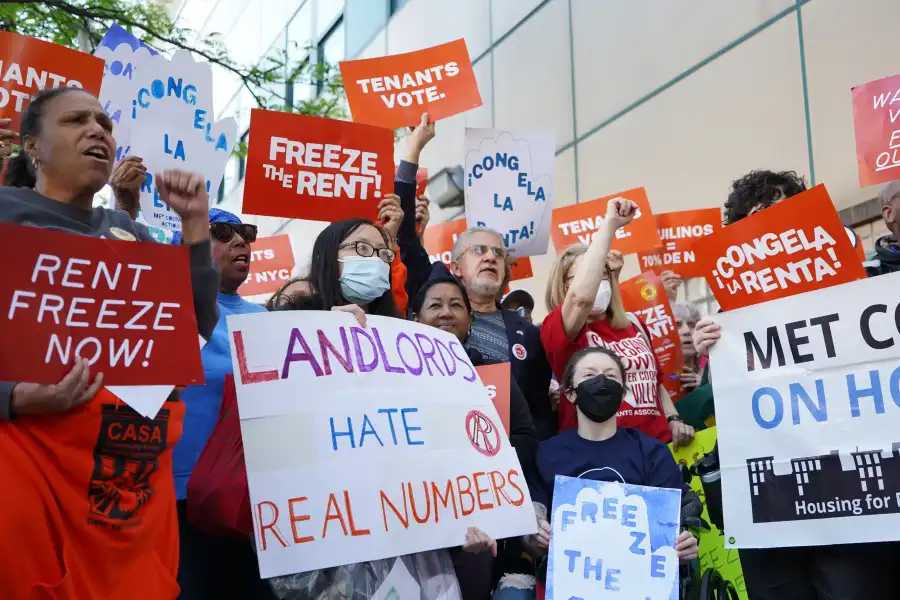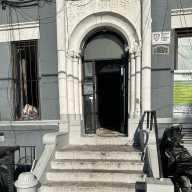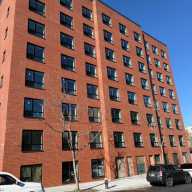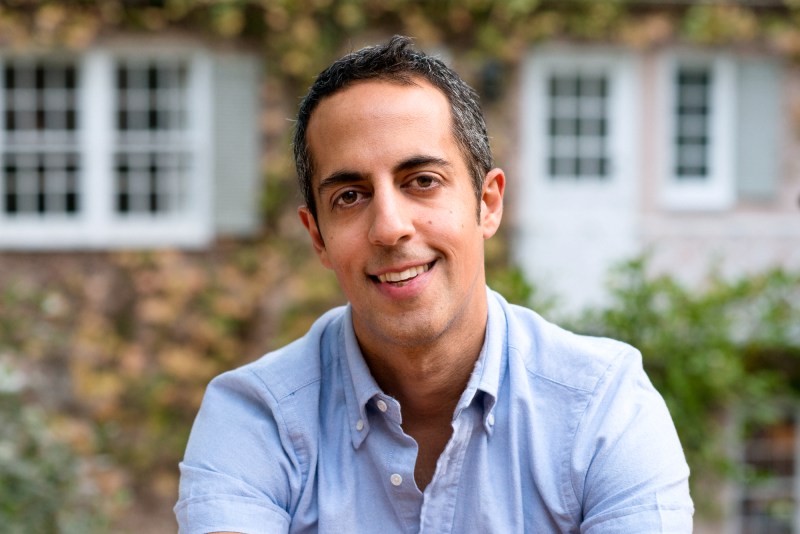
With the city facing a housing and affordability crisis, a rent freeze is very much on the minds of New Yorkers.
The Rent Guidelines Board (RGB) is preparing to vote June 27 on a possible rent increase for rent-stabilized buildings, and advocates on both sides are sounding off, each warning that the decision has serious ramifications for tenants and the viability of New York City’s housing stock.
The mayor-appointed, nine-member board will soon decide whether the city’s 2.4 million rent-stabilized tenants will pay between 3.75% and 7.75% more for two-year leases, or 1.75% to 4.75% more for one-year leases starting in October — or have no increase, commonly referred to as a “rent freeze.”
Either way, the decision will impact many New Yorkers. About half of the city’s rental apartments, about a million total, are rent-stabilized. Most rental apartments built before 1974 with more than six units are rent-stabilized, as are all the newer city-subsidized affordable apartments receiving special tax breaks.
That means these many properties are subject to the Rent Guidelines Board’s annual decisions about whether or not to increase the rent — with an RGB vote being their only means of doing so.
The RGB under Mayor Eric Adams has voted to increase rents each year of his tenure, totaling a 9% increase over the past three years. By contrast, rents were frozen three times under former Mayor Bill de Blasio, in 2015, 2016 and 2020.
The idea of a rent freeze has widespread approval today, according to a recent poll. An April 2025 survey by the left-leaning think tank Data for Progress showed that 78% of likely New York City voters support a rent freeze. Significantly, it had bipartisan support, with 83% of Democrats and 63% of Republicans saying they favored it, the poll found.
Supporters argue that property owners do not need a rent increase because they are already turning a profit. They contend that landlords can cover their maintenance and operating expenses without raising rents.
But owners say a rent increase is necessary to keep up with rising costs of insurance, utilities, labor and more. They say the 2019 Housing Stability and Tenant Protection Act (HSTPA) significantly limited their ability to raise rents or recover the costs of building upgrades, restricting them to only the modest increases set by the Rent Guidelines Board. This financial pressure, they warn, threatens the long-term viability of rent-stabilized buildings and could lead to the deterioration or loss of affordable housing across the city.

“Public Enemy No. 1”
The 2019 law appeared to mark a turning point in tenants’ favor — and became “Public Enemy No. 1″ for owners, as the commercial real estate outlet Bisnow referred to it.
The law capped the amount landlords can raise rent in exchange for costly repairs, such as roof replacements, new plumbing or new boiler systems, in their buildings and in individual apartments after a tenant leaves.
Since many rent-stabilized tenants live in their homes for decades or even generations, it can be very costly to rehab them upon vacancy — and some owners say the cap prevents them from recouping the costs.
Cuomo signed the 2019 tenant-friendly law as governor but now seems to be backing off his support. Notably, one PAC supporting his campaign, Housing For All, is entirely funded by the New York Apartment Association, which represents most of the city’s rent-stabilized owners. With a planned $2.5 million spend on Cuomo’s behalf, Housing For All recently became the top donor to any mayoral candidate.
Regardless of the politics, the 2019 changes, not to mention the hardships of the pandemic that soon followed, marked a major shift in the city’s affordable housing landscape.
Some say the law ended up screwing owners, whereas others argue that the law protects tenants from getting screwed by landlords
The politics of a rent freeze
Tenant advocates have made a rent freeze a key issue in the upcoming primary, particularly for those running for mayor.
Supporters of the freeze argue that rent-stabilized tenants—who represent the city’s lower- to middle-income earners—are struggling to keep housing costs manageable as expenses for groceries, utilities, and other essentials continue to rise.
According to 2022 RGB data, the median rent-stabilized household earns $60,000, compared to $70,000 for all renters, and the median rent for these units is $1,500.
Several Democratic mayoral candidates have come out in favor of at least a one-year freeze, whereas Andrew Cuomo, the current front-runner, stands alone in opposition, citing the increased costs of maintaining properties.
In his 28-page housing policy, Cuomo said, “[A rent freeze] is a politically convenient posture, but if landlords — small landlords in particular — do not receive rent increases that reflect their costs, they will be unable to maintain their buildings.”
“While this is a political year, this is not a political decision,” he said in a campaign statement. “The board must ultimately balance the economic realities necessary to prevent buildings from falling into disrepair with the hardship facing too many New York families.”
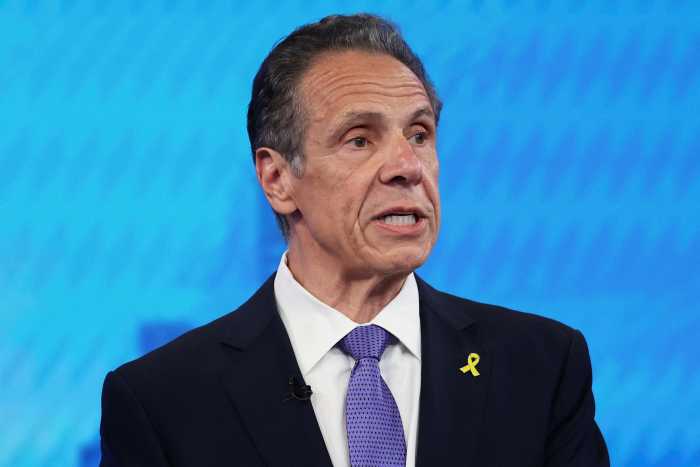
Mayor Adams, who is running for re-election as an Independent, also appears to be against a rent freeze.
He said he is concerned about owners, especially those who only own few properties, not earning enough rental income and letting their properties fall into distress.
“[The price of] Gas doesn’t freeze. Electricity doesn’t freeze. Insurance doesn’t freeze. The cost of running a building doesn’t freeze,” Adams said in an April 28 media appearance.
On the other end of the spectrum, Queens Assembly Member Zohran Mamdani, polling in an increasingly-closer second place, said that if elected, he would freeze the rent for his entire four-year term.
If rents were frozen from October 2026 through September 2030, tenants could collectively save $2.44 billion to $6.84 billion in rent, which would flow back into the city’s economy, according to a report by the Community Service Society, a social welfare nonprofit.
All the other Democratic candidates besides Cuomo — Comptroller Brad Lander, City Council Speaker Adrienne Adams, former Bronx Assembly Member Michael Blake, former Comptroller Scott Stringer and State Sens. Zellnor Myrie and Jessica Ramos — have said they support freezing the rent for at least this year.
Setting rents is “one of the most consequential things that city government does” and rests entirely within the mayor’s control, as the mayor appoints the RGB decision-makers, said Cea Weaver, director of the New York State Tenant Bloc.
A rent freeze also doesn’t require a budget to be passed or a new law to be signed, she said. This year, with many renters feeling pinched by a tight economy, they’ve mobilized to put a rent freeze on the ballot — and whoever is elected mayor must hear their concerns, said Weaver.
There are too many renters for candidates to ignore, she said. “The city runs on rent-stabilized tenants.”
The RGB’s “impossible” task
The debate over a rent freeze illustrates the complexity of the city’s affordable housing landscape and the delicate balance between affordability and preservation that the RGB must attempt to strike.
If they raise rents too much, tenants won’t be able to pay — and if they don’t raise rents enough, landlords won’t have enough funds to maintain and repair their buildings.
But Mark A. Willis, senior policy fellow at the NYU Furman Center, believes that the RGB’s balancing act is actually impossible in an era of inflation.
In a June 2 interview with amNewYork, Willis said the board’s dual mandate of keeping rents reasonable while also ensuring owners can cover operating costs cannot be achieved under inflation and with the board having only one tool — raising rents by a limited amount — at its disposal.
RGB data shows that insurance costs alone rose nearly 18.7% this year, and owners’ overall operating costs increased 6.3% — higher than the upper limit of the board’s potential rent hike for one-year leases.
Under the Adams administration rent increases, owners’ Net Operating Income (remainder after paying operating costs) rose 12% on average between 2022 and 2023, or 8% when adjusted for inflation. But Willis said many today are still not earning enough to cover their costs.
If there were no inflation, it would be easy to impose a rent freeze, he said. But in today’s reality, and under the 2019 law, rent-stabilized owners have no options besides what the RGB decides on their behalf.
Willis said there are valid arguments for and against a rent freeze. Many tenants’ incomes have not kept up with inflation, and many owners do not take in enough rental income to maintain their buildings properly.
Unless the world had no inflation, “There’s no way the RGB can satisfy both at the same time,” said Willis.
In his April 10 testimony to the Rent Guidelines Board, Willis pointed to about 200,000 citywide units most at risk of financial insolvency and highlighted the Bronx as a case study.
For 100% rent-stabilized Bronx buildings built before 1974, the RGB’s rent increases between 2010 and 2023 did not keep up with operating costs, falling short by 1% each year, he testified.
During that time, what owners spent on operating costs fell by over 7% when adjusted for inflation. Their net operating income increased modestly, but not enough to fully cover costs, which rose quicker than inflation.
By 2024, it was estimated that since 2019, the rent shortfall for each unit was already up to $1,444 per year, exceeding one month’s rent.
Landlords in this situation need help, and tenants need them to continue providing affordable homes, Willis said.
“You shouldn’t not help the owners with building with such low rents because of concerns that other owners are thought to have exploited the system that existed before 2019,” he told amNewYork.
He said the city must find other ways to help people who are struggling to pay rent while also ensuring owners don’t fall into distress and bankruptcy.
Costly subsidies to fill the gap may be necessary, but the problem is long-term and requires complex solutions. The bottom line is that the city desperately needs to preserve the affordable housing it already has, said Willis. The current vacancy rate for rent-stabilized units is only 0.98%, according to the RGB.
“If you don’t make it possible for the good guys — that is, there are some landlords who want to do the right thing — to be able to properly maintain the buildings, you’re going to lose the stock,” he said.
‘Death spiral’
Former Bronx Assembly Member Kenny Burgos now leads the New York Apartment Association, a 501(c)(6) organization representing thousands of owners, many of whom have rent-stabilized buildings that have been passed down through generations, he told amNewYork Metro.
Burgos’ group, via its Housing for All PAC, is now backing Cuomo and is the biggest donor to any candidate in the mayoral race. The NYAA is calling for the RGB to “stop the bleeding” with a 6.25% rent increase on one-year leases.
In an interview with amNewYork, Burgos painted a stark reality of the housing landscape, saying that the RGB and “unfunded mandates” like the 2019 laws have led to a “systematic defunding of housing” in the city.
According to Burgos, the blanket rent freeze that many are advocating for would have unintended consequences and “would actually send these buildings that these tenants live in into a death spiral.”
He blasted the mayoral candidates for “pandering” to tenants.
“To me, a blanket rent freeze is probably one of the most irresponsible policy decisions that any elected official could have right now,” said Burgos.
He said he understands frustration over rent increases and that many tenants are financially struggling. But the RGB has repeatedly underestimated the costs of operating housing, and keeping rents too low will backfire, he said.
RGB rent increases are “the only mechanism” for owners to keep up with rising costs of property taxes, insurance, labor costs, utility rates, he said. If they don’t collect enough revenue, many will stop maintaining and repairing their buildings, and some may lose them.
Burgos said that even many lifelong New Yorkers don’t fully grasp the complex housing environment and expense of operating housing in NYC.
A rent freeze sounds good, but “really doesn’t serve the people it’s trying to serve,” he said.
Lack of trust
Those in favor of a rent freeze argue that owners are making more than enough profits to cover increased operating costs — and are often skeptical that revenue from past RGB increases is actually being used to improve properties.
Fitzroy Christian, who has lived in his 50-unit, six-story Morris Heights, Bronx apartment building since 1976, said he advocates for a rent freeze on behalf of his many neighbors who struggle to afford living in the city.
Christian said although he doesn’t have much difficulty affording $1,031 in rent for his two-bedroom apartment, many of his neighbors do.
“It is not everyone in the southwest Bronx who had the fortune I had,” he said in an interview with the Bronx Times on June 2.
Many would consider Christian’s rent shockingly low for anywhere in NYC — but it comes at a cost.
His building has 39 open housing code violations with the city Department of Housing Preservation and Development (HPD), and he said he experienced three partial ceiling collapses in three years, along with inconsistent heat and hot water and pest infestations. Everyone in the building has these problems, regardless of their income, said Christian.
He said a rent reduction would actually be appropriate in their case, but a freeze would at least help “ease the trauma” for people who are already making sacrifices “that no human being should have to be making,” such as skipping meals or taking partial doses of medications to save money, he said.
Even beyond tenants’ ability to pay, a lack of trust in landlords appears to be another factor motivating some rent freeze supporters.
Yun Chen, who has lived in Chinatown for 29 years, told amNewYork that she does not believe her landlord is using the income from recent rent hikes to better maintain the property, which was built in 1900.
No major repairs have been made in her rent-stabilized building on Monroe Street since 2008, said Chen, speaking through a Mandarin translator.
The building has changed hands several times during her years there, and now, no one seems to be taking action to replace the water pipes, which she said appear very old and leaky, resulting in an unreliable hot water supply. A neighbor once had plaster bits of his ceiling fall down due to a water leak from the floor above, Chen said.
“Only surface repairs” have been done for many years, she said. “What are the landlords paying for?”
Chen is not the only one calling for more transparency.
Landlords could open up their books to prove to the RGB that a rent increase is necessary, but they don’t usually do so, said Weaver with the New York State Tenant Bloc.
A few owners actually did open their books to the commercial real estate reporting outlet Bisnow and showed that their net income has fallen significantly since the 2019 law was passed.
Financial records showed that the owner of 100 rent-stabilized Queens units had steadily rising income from 2019 to 2021, which then dropped off from a peak of $340,000 down to $177,512 in 2024.
In the Bronx, an owner of 80 units made close to $174,000 in 2019 but dropped to $29,192 in 2024.

But many tenants and advocacy groups aren’t buying it and believe an RGB rent increase of any amount is unwarranted.
Many landlords simply made unsound investments and want to pass the problem onto tenants, Weaver said. Instead of upping rents, owners should seek city and state help in covering costs if needed.
“It’s not our job as tenants to cover landlords’ asses for their bad investment,” she said.
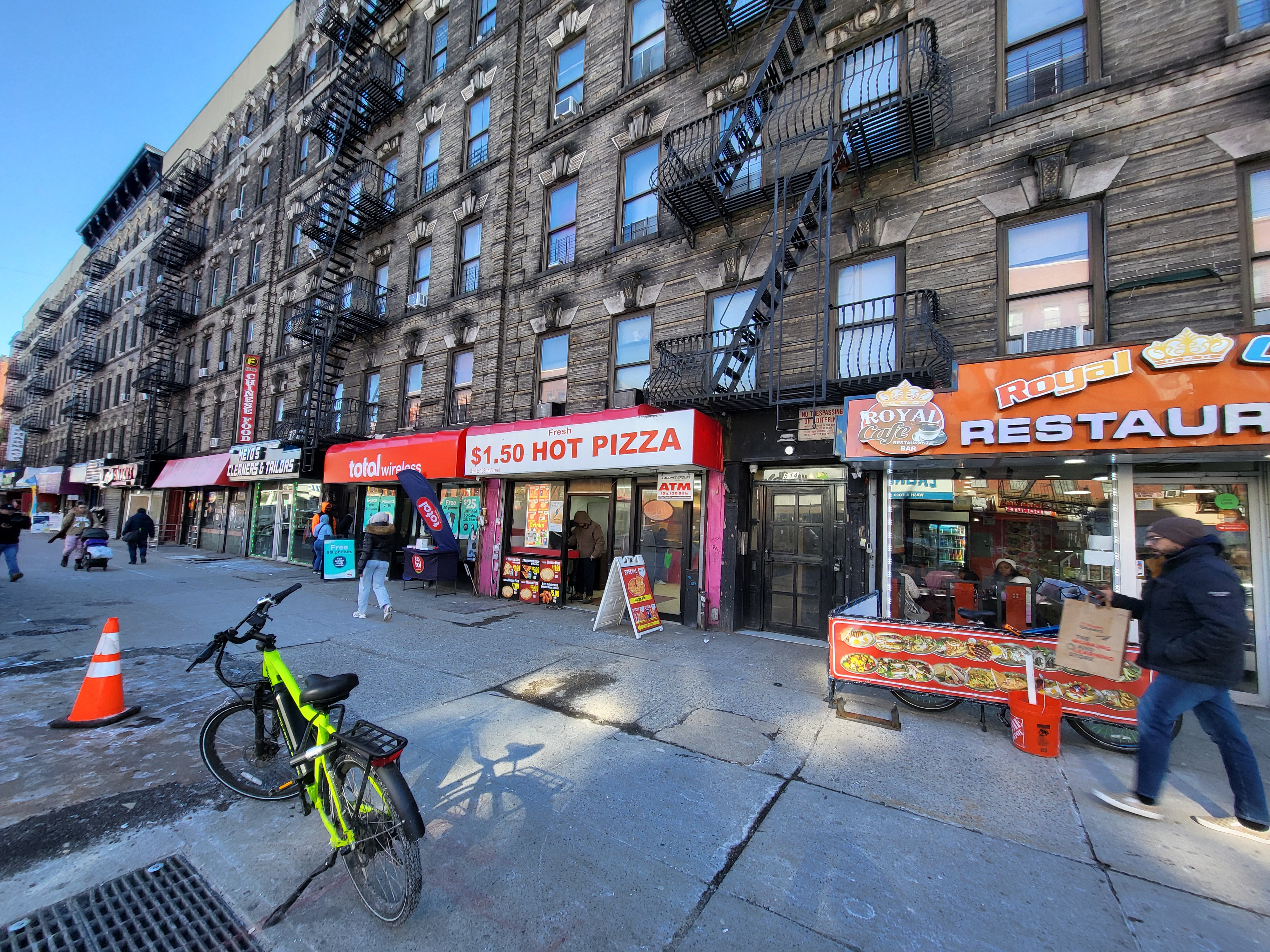
Existing rent freezes
The city already has two rent freeze programs: SCRIE and DRIE, the Senior Citizen Rent Increase Exemption (ages 62 and up) and Disability Rent Increase Exemption. These programs ensure that enrolled individuals only pay a set amount, even if rents in their building increase.
Applicants must meet criteria beyond being a senior or disabled, including living in a rent-stabilized building, Mitchell Lama cooperative or some other approved type of housing, and receiving income from federal sources such as Social Security or the Veterans’ Administration.
Advocates have expressed frustration that many middle-income tenants earn too much to qualify for SCRIE and DRIE and still struggle to pay rent. But Burgos said these programs as they exist are still more effective than a blanket rent freeze.
Under SCRIE and DRIE, if the building owner increases the rent, enrolled tenants pay the same amount as before, and owners receive a tax break to cover what’s missing.
Chen in Chinatown retired two years ago and is enrolled in SCRIE, which froze her rent at $1,130 per month for a two-bedroom apartment. Others in the building are paying $1,600, she said.
Burgos with the New York Apartment Association said these programs “actually work” because they consider tenants’ ability to pay while also covering owners’ costs. About 100,000 New Yorkers are enrolled, and even more qualify but are not signed up, he said.
Due to these rent freeze programs, 170,000 rent-stabilized units will not experience an increase, regardless of how the Rent Guidelines Board votes, said Burgos.
He advocates for expanding these programs to allow more people to qualify and for bolstering enrollment efforts.
Unlike a blanket rent freeze, which “really doesn’t serve the people it’s trying to serve,” Burgos said rent freeze programs that consider tenants’ limited income — while still covering for owners — are a sensible option.
As the RGB faces its June 27 vote and New York City voters prepare to head to the polls, tenants like Christian in the Bronx and Chen in Chinatown are talking to their neighbors and throwing their support behind rent freeze-friendly mayoral candidates.
Building strong community bonds will help residents prepare for whatever comes next, said Christian. “We can only survive as a community, as a group,” he said. “When one of us suffers, it is a threat to all of us.”
This story was updated June 9 at 2:00 p.m. with correction on the PAC supporting Cuomo’s campaign.
Reach Emily Swanson at eswanson@schnepsmedia.com or (646) 717-0015. For more coverage, follow us on Twitter, Facebook and Instagram @bronxtimes

